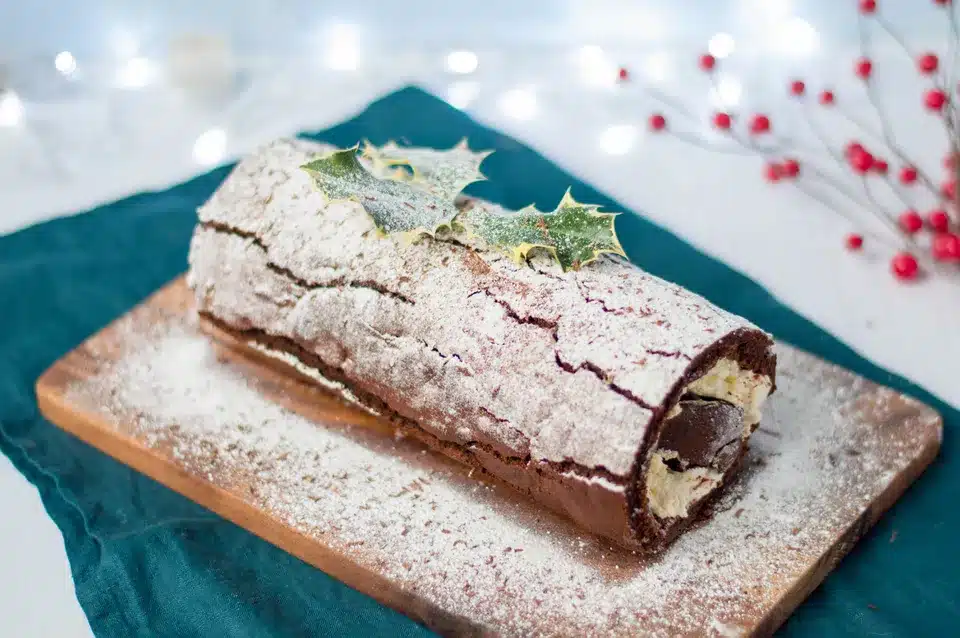Prior to the Industrial Revolution, Christmas would take place over 12 days. This would change because most people would go back to work the day after Christmas rather than celebrating for over a week.

On the 12th day of Christmas, folks would eat a delicious fruit cake to wind down the festivities. The fruit cake would be the beginning of a new Christmas tradition, the Christmas Cake.
While this tradition is not as widespread as it once was, it is still around today. I can remember it being mentioned in movies as a kid and the fruit cakes being served at different events.
According to Why Christmas, these cakes were more than just something sweet to eat on the final day:
Twelfth Cakes also had a bean or pea cooked in them, and the finder of the bean or pea became the King or Queen of the Twelfth Night party. When Twelfth Cakes became Christmas Cakes, the custom of putting tokens into a dish moved into the still 'alcoholic' Christmas Pudding, and Christmas Cakes also became a 'nicer' dish that could be served at afternoon tea, which was very popular with middle and upper-class Victorians.
Christmas Cake Throughout Great Britain
Christmas cake is an English tradition that began as plum porridge. A traditional English Christmas cake is made with moist Zante currants, sultanas (golden raisins), and raisins that have been soaked in rum. The cake may be covered in icing and decorated, often with models of houses, fir trees, or Father Christmas.
A Scottish specialty is the traditional Christmas cake, the "Whisky Dundee." As the name implies, the cake originated in Dundee and is made with Scotch whisky. It is a light and crumbly cake, and light on fruit and candied peel, only currants, raisins, sultanas, and cherries. There is also the Scottish black bun, of a similar recipe using whisky and often caraway seeds, eaten on Hogmanay
Aside from candied cherries, some Christmas cake recipes call for angelica as a green color.
Coins were also occasionally added to Christmas cakes, as well as Christmas puddings as good luck touch pieces. The usual choices were silver 3d pieces or sixpences, sometimes wrapped in greaseproof paper packages.
In Yorkshire, Christmas cake, as with other types of fruit cake, can be eaten with cheese, such as in Wensleydale.
A cake that may also be served at Christmas time in the United Kingdom, in addition to the traditional Christmas cake, is the cake known as a "Yule Log, or chocolate log." This is a Swiss roll that is coated in chocolate, resembling a log.
The Christmas cake largely displaced the previously popular Twelfth-night cake during the Victorian era.
Across the World
In the United States, some people give fruitcakes as gifts at Christmas time, but they are not called Christmas cakes.
In Canada, however, the same cake is instead called "Christmas cake," at least among the English-speaking majority.
In India, Christmas cakes are traditionally fruit cakes with many variants. Allahabadi cake is famous for its rich taste and texture. Many smaller and more traditional Christian bakeries add alcohol, usually rum, to the cake.
In Sri Lanka, Christmas cakes use treacle instead of cane sugar and include spices like nutmeg, cinnamon, and black pepper.
In Japan, Christmas cakes are traditionally eaten on Christmas Eve. The cake is simply a sponge cake, frosted with whipped cream, often decorated with strawberries, and usually topped with Christmas chocolates or other seasonal fruits and a Santa Claus decoration. Christmas cakes of this style were originally released by Fujiya and were popularized when they began sales at Ginza, the central commercial district in Tokyo.
In the Philippines, Christmas cakes are bright, rich yellow pound cakes with macerated nuts or fruitcakes of British fashion. Both are soaked in copious amounts of brandy or rum mixed with a simple syrup of palm sugar and water.
In Cyprus, Christmas cake is much like the UK and is served on Christmas Day. It is the first treat the locals serve to their guests.
In Germany, Stollen, a traditional German fruitcake, is popular. During the Christmas season, it's also called Weihnachtsstollen or Christstollen.
In Italy, Panettone, a slice of sweet sourdough bread with a distinct cupola shape, is traditionally eaten at Christmas. It contains raisins and candied citrus fruit and is prepared meticulously over several days. Pandoro is typically a Veronese product. Is traditionally shaped like a frustum with an eight-pointed star section.
The "Pandolce Genovese" is also a famous Christmas cake. The name "Genovese" refers to its city of origin, Genoa. It is similar to a British fruitcake but less tall and more crumbly.
In France, in Belgium, in Switzerland, in French Canada, in Luxembourg, and in Lebanon, a Bûche de Noël (Yule Log cake) is the traditional Christmas cake. They are light sponge cakes covered with a layer of buttercream flavored with chocolate, coffee, and Grand Marnier ... Then rolled and covered with another layer of buttercream, which is streaked and sprinkled with powdered sugar to simulate a log of wood covered with snow.

